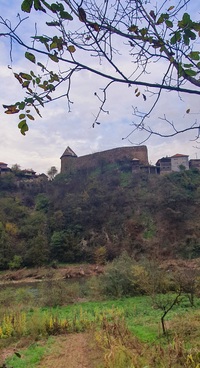Photo. Vranduk Castle stands in the middle of a breathtaking landscape. © Travel Explorations.
Entering Vranduk Castle felt like stepping into a world shaped by kings and warriors. Inside the castle, I took a shot with a bow and arrow, channelling the spirit of the medieval defenders who once guarded these walls. It was thrilling to imagine standing in their place, aiming over the castle’s steep rock and into the valley below. The breathtaking views of the surrounding landscape, combined with the dramatic history dating back to the 15th century, created an atmosphere rich with stories of the past.
The castle's elevated position offered a tactical advantage, allowing defenders to monitor and control the valley below. It stands as a remarkable example of classic medieval architecture, with thick stone walls, narrow passageways, and a central tower serving as a lookout and final stronghold.
Vranduk Castle is significant in Bosnian history. Its location and history summarise the medieval era's when Bosnia struggled to maintain sovereignty amidst external threats. Built between the 14th and 15th centuries, the castle was a royal residence, most notably for King Stjepan Tomaš, who ruled during a time of significant political and military challenges. His reign marked one of Bosnia’s last periods of independence before the Ottoman Empire's arrival.
Despite its strategic location and strong defences, the castle fell to the formidable Ottoman military power, marking a turning point as the Ottomans ruled Bosnia for over 400 years. Their presence added a unique cultural layer to the fortress and surrounding village, blending Bosnian and Ottoman history into one site. Traces of Ottoman architecture and inscriptions within its walls mark this shift in Bosnia’s political landscape. It`s also a small mosque there. It was erected below the citadel after the Ottoman conquest of the Bosnian Kingdom which still is standing today in good condition. The mosque was dedicated to and named after Sultan Mehmed II, conqueror of Bosnia, and is also referred to as the Imperial Mosque or Emperor's Mosque.
The nearby village of Vranduk still preserves Ottoman architectural elements, providing a rich, layered historical experience.
Within the castle, I visited a small museum displaying artifacts from Bosnia's medieval period. There I got a glimpse into the daily lives of its former residents. The preserved interiors, including the guard’s quarters and observation points, brought the medieval atmosphere to life, that gave me an impression how people lived and defended their home.
Beyond the Vranduk Castle walls, the surrounding landscape invites to further exploration. The lush trails winding through the valley offer various vantage points of this historical site above. Hiking through the Bosnian wilderness that encircles the castle, you will get views of mountains and rivers. This makes the region of Vranduk a wonderful place where history, culture, and nature meet.
Stein Morten Lund,
30th October, 2024
Additional information












